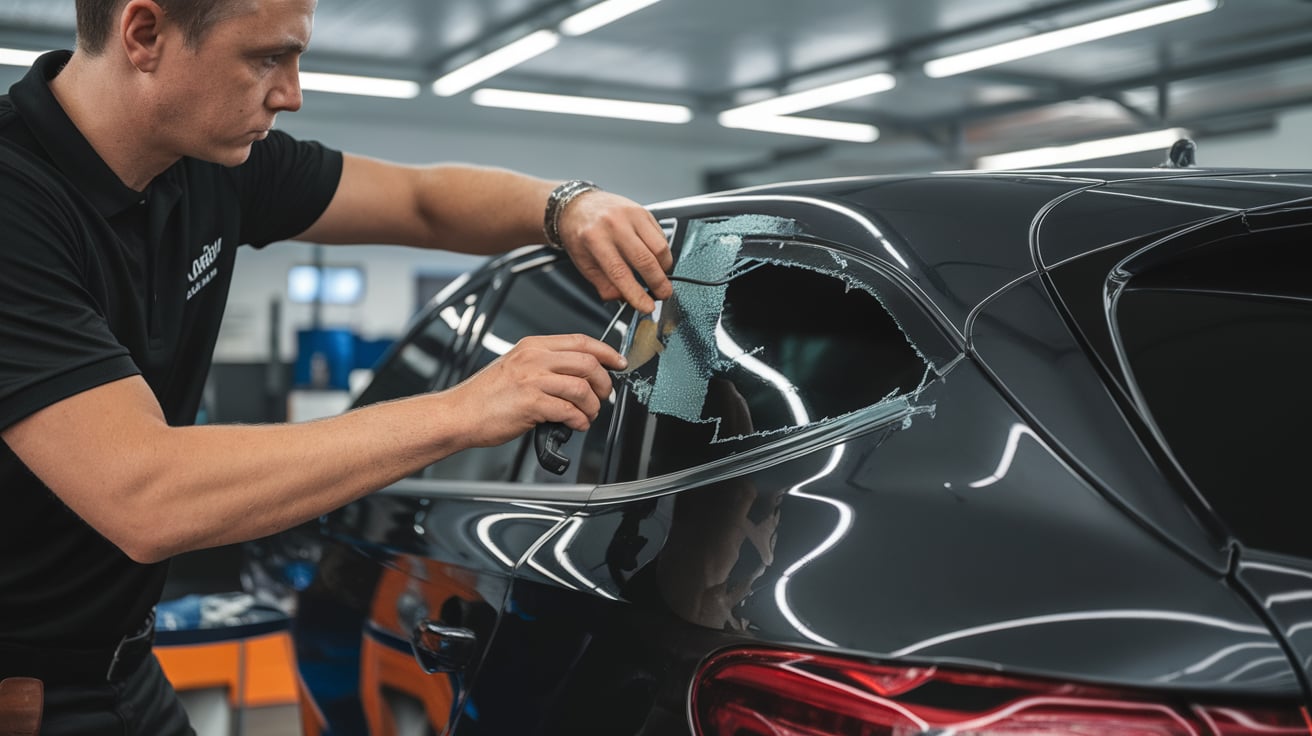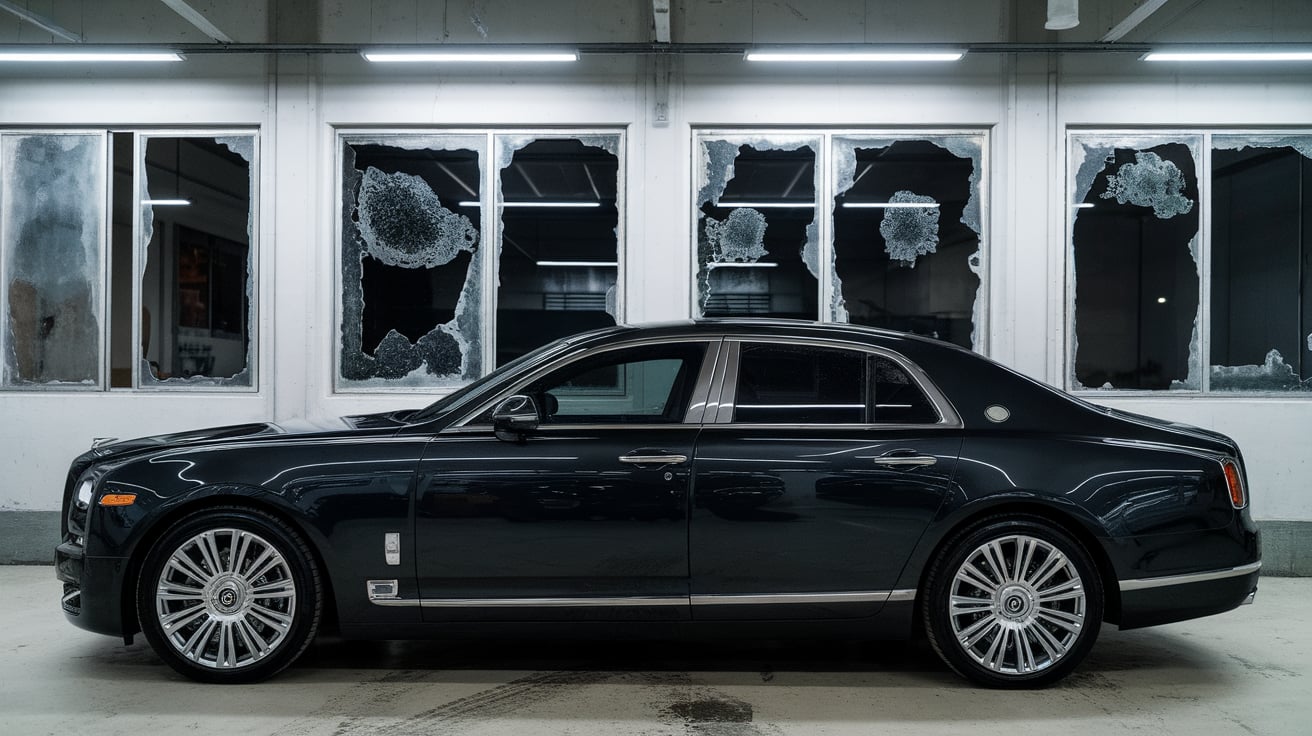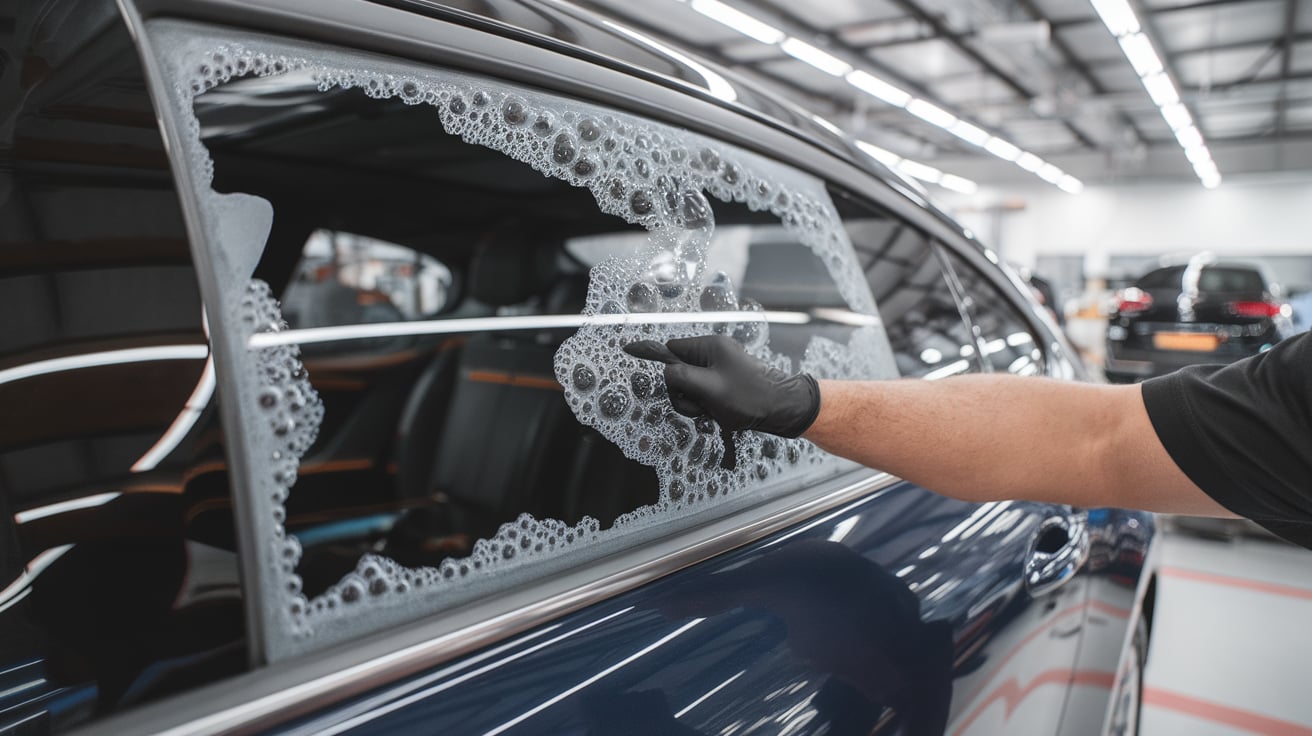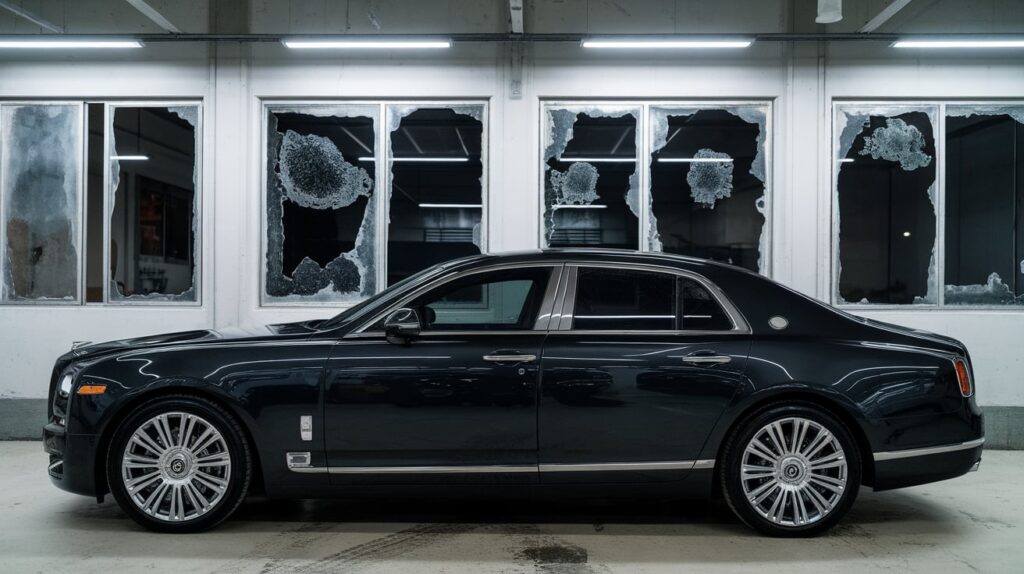You know the feeling: blistering heat, burning seats, AC struggling while the sun blazes through the windshield. In places like Dubai, interior temperatures can reach 130°F quickly, and that kind of heat ages everything: your dashboard, your upholstery, and even your patience.
That’s why smart drivers aren’t skipping tint anymore, they’re upgrading. And in this market, the debate’s intense: ceramic tint vs carbon tint is the real clash. Owners want more than shade. They want performance heat rejection, clarity, and no signal interference. High-end garages across the UAE and Pakistan are flooded with demand. Everyone’s asking: Which tint tech survives the heat, boosts resale value, and still looks sleek? Let’s settle it, ceramic tint vs carbon tint, from the inside out.
What Are Ceramic and Carbon Tints? | Breaking Down the Technology
The debate over ceramic tint vs carbon tint is not just marketing noise, it’s a clash of how differently these films behave once installed. One’s engineered for pure performance, the other for pragmatic appeal. But before we crown a winner, we need to understand what each is made of and why it matters.
Ceramic Tint Defined
This is where window tinting steps into the realm of high-tech. Ceramic tints use non-metallic, non-conductive nanoparticles, often embedded in multiple layers of optical-grade polyester film. They’re not glossy, they’re not flashy, and that’s exactly the point.
- Composition: At the heart of ceramic film is a stack of microscopic ceramic particles that block infrared radiation without compromising visibility.
- Coating layers: Advanced films include UV inhibitors, scratch-resistant top coats, and pressure-sensitive adhesives that ensure long-term bonding without hazing.
- Performance: Ceramic tints shine in infrared heat rejection, often blocking over 80% of IR rays. Even under Dubai’s brutal afternoon glare, the temperature drop inside a ceramic-tinted vehicle can be drastic. Plus, they offer sharp clarity, especially important for low-profile luxury glass.
Now here’s the part workshop installers love: no signal interference. Unlike metallic tints, ceramic films allow GPS, Bluetooth, and mobile signals to pass through untouched. That matters if your car has navigation, wireless controls, or a factory-integrated media system, which most high-end rides do.
If you’re after the kind of cooling that’s felt, not just promised, ceramic delivers. But it’s not cheap, and that’s where carbon tint tries to strike back.
Carbon Tint Defined
Carbon tint doesn’t rely on ceramic particles or expensive nano-tech. Instead, it incorporates carbon-infused layers within the polyester film to absorb solar energy and reduce glare. It’s matte, it’s aggressive-looking, and in some cases, it’s surprisingly effective.
- Material makeup: These films contain pulverized carbon molecules dispersed across layers, creating a dark, even finish with low reflectivity.
- Visual appeal: It’s got bite, especially if you want that classic blackout aesthetic. No metallic shimmer, no mirror effect, just rich contrast that fits well with SUVs, off-road builds, and blacked-out performance sedans.
- Heat resistance: Carbon does block infrared rays, but not quite at the level that ceramic does. You’ll feel the improvement, just not as dramatically.
That said, carbon tint has two undeniable strengths: affordability and stability. It won’t interfere with your signals either. And while its IR rejection isn’t top-tier, it’s solid enough for daily drivers that don’t need surgical-grade climate control.
Installation Notes for Both
While both films are pressure-sensitive and applied using water-activated adhesives, there’s a difference in how they “shrink” to curved glass. Ceramic can be trickier; it demands a skilled hand, especially on frameless doors and sloped rear windshields. Carbon? More forgiving, easier to install on standard factory glass, and less prone to bubbling if the prep work isn’t surgical.
If you run a detailing bay in Dubai, that’s something to consider when quoting tint jobs. Skill level matters, and bad installs can kill even the best film.
Whether you’re after stealth aesthetics or tech-backed performance, ceramic tint vs carbon tint is a decision that starts with the build and ends with how it handles real heat. Ceramic offers top-tier heat rejection and signal clarity, ideal for Dubai’s brutal summers. If you’re leaning toward advanced protection, our ceramic tinting service in Dubai delivers that balance of style and performance. Next up: we put these films through a full performance face-off.

Performance Metrics Face-Off | Ceramic Tint vs Carbon Tint
If you’re living in Dubai, you already know it’s not just about blocking sunlight. It’s about how your tint performs when the temperature climbs, traffic crawls, and visibility matters. Let’s break this down, point by point, through the real lens of ceramic tint vs carbon tint, using observations straight from regional shops.
UV Rejection
Both ceramic and carbon tints claim UV protection, but how far does that go?
- Ceramic tint typically blocks up to 99% of UV rays, thanks to its nanoparticle makeup. That’s why detailing pros in Al Quoz recommend it for clients with premium leather interiors and sensitive electronics it slows down fading and keeps the cabin cooler long-term.
- Carbon tint? It holds up respectably; most mid-tier films offer around 80–95% UV rejection, depending on the brand.
Verdict: If UV protection is your top priority, ceramic takes the crown, especially under the punishing summer sun.
Infrared Heat Reduction
Here’s the part that either makes or breaks your AC system.
- Ceramic tint excels at infrared rejection. Lab tests at Dubai’s Tint Studio X show up to 85% IR blocking, with in-car temperature drops of up to 20°F on peak days. Luxury car owners who’ve switched from carbon say it’s not just cooler—it’s quieter, because the AC doesn’t struggle.
- Carbon tint does reduce heat, but it’s less aggressive. Results from Gujarat’s AutoShield detailing bay showed an average 10–12°F drop, which is decent for the price but less effective under full exposure.
Verdict: For heat reduction that feels different, ceramic is miles ahead.
Glare Control
Ever missed a turn because the sun turned your dash into a mirror?
- Ceramic films offer strong glare reduction while preserving visibility. Drive tests in Abu Dhabi found drivers using ceramic experienced a 35–50% glare cutback without tint-induced haze.
- Carbon tints perform well, too. Thanks to their deep, matte finish, they cut glare by 25–40%.
Verdict: Both perform well, but ceramic wins if clarity matters more than darkness.
Signal Interference | GPS, Mobile, Radio
This is where misinformation runs wild. Some clients walk in saying, “Does ceramic block my GPS?” Let’s sort that.
- Ceramic tints are non-metallic, meaning zero interference with your car’s electronics. Bluetooth, Wi-Fi, and radio all work flawlessly. That’s why Tesla installers in Dubai won’t touch metallic or hybrid tints anymore; they stick to ceramic only.
- Carbon tint also passes the test. It’s metal-free too, though lesser-known brands may show slight signal degradation if mixed with hybrid layers.
Verdict: It’s a draw here, ceramic tint vs carbon tint; both keep your tech intact.
Optical Clarity and Visibility
When you’re driving late at night or in dense fog, this metric hits differently.
- Ceramic tint stands out for its optical-grade clarity. High-end variants from brands like Hüper Optik or 3M Crystalline remain crystal clear even in 20% VLT levels. Detailers in Dubai say it’s the go-to for custom-cut installs on panoramic glass roofs.
- Carbon tint leans toward a darker, “smoked” aesthetic. While visibility is solid during the day, night driving can feel muted, especially with lower VLT percentages.
Verdict: For sharp visuals across all conditions, ceramic stays in focus.
Aesthetic Appeal in Daylight and Nighttime
Looks matter. And they shift once the sun dips.
- Ceramic tints tend to be neutral-toned. They blend seamlessly with luxury paintwork Porsche, Lexus, and even Range Rovers, and look more refined when paired with ceramic. Shops in JLT say clients often “don’t want the tint to announce itself.”
- Carbon tints, on the other hand, bring attitude. The finish is darker, the contrast stronger. Street builds and matte wrap projects in Gujarat often rely on carbon to complete that murdered-out look.
Verdict: Depends on taste. Ceramic is elegant, carbon is bold.
Every tint metric tells a story. Whether you’re chasing raw heat rejection, sleek aesthetics, or signal-safe tech, the ceramic tint vs carbon tint showdown proves there’s no one-size-fits-all, just smarter choices based on need.
Durability, Maintenance & Longevity
The truth is, no matter how impressive a tint looks on Day One, what matters is how it holds up after two sweltering summers, a few sandstorms, and a couple of rushed car washes. If you’ve ever seen bubbling around the rear window or streaks where a film started breaking down, that’s not just a bad install. That’s poor material performance. So, when you’re comparing ceramic tint vs carbon tint, longevity and resilience deserve more attention than hype.
Scratch Resistance and Film Integrity
- Ceramic tint, especially high-end versions like 3M Crystalline or Llumar IRX, comes with advanced topcoats. These resist surface scratches from casual contact, seatbelt slaps, rings, keys even some microfiber mishandling. It’s not invincible, but it’s better protected.
- Carbon tint tends to be less robust. Shops report minor scuffing after just 6–8 months on vehicles exposed to rough local conditions. The matte finish helps hide damage, but it does not prevent it.
TIP: Ceramic holds up better to daily wear, but both still need proper cleaning no harsh chemicals, no dry rubbing.
Fading & Color Retention Over Time
Here’s where things start separating clearly.
- Ceramic tint keeps its tone stable. Whether you choose charcoal or graphite shades, they stay neutral. A recent Audi Q7 test in JLT showed zero discoloration after 14 months of roof-down sun exposure.
- Carbon tint can shift. That deep black slowly drifts toward brownish-grey.
Verdict: Ceramic films are colorfast. Carbon? Depends on quality, but don’t expect long-term consistency.
Summer Survival & Dust Resistance
This matters more in Dubai and Pakistan than in most places.
- Ceramic tint resists UV and heat deformation extremely well. It doesn’t bubble, curl, or haze even on wraparound glass or sunroof installs. The adhesive formulas used are built to hold steady through 130°F cabin temperatures, and dusty conditions don’t seem to degrade bonding.
- Carbon tint, while resilient at first, can start lifting at the edges during the second summer cycle. Detailing workshops in Karachi say rear glass and hatch installs are especially vulnerable.
CASE EXAMPLE: A 2022 Land Cruiser VX in Dubai had ceramic on all sides except the cargo glass. The carbon section began hazing by year two. That customer later requested a full re-tint.
Maintenance Requirements
Maintaining the performance isn’t complicated—but it does differ.
- Ceramic tint tolerates proper detailing procedures well. Soap water, ammonia-free solutions, and microfiber wipes won’t harm it. But due to its clarity, even small smudges or streaks can show more, so frequent cleaning matters.
- Carbon tint is lower-maintenance visually. It hides dust and light scratches better, but it’s also more porous. That means it’s more prone to adhesive contamination if cleaned incorrectly.
TIP: Never use ammonia-based cleaners on either. And always advise clients to wait at least 48 hours post-install before cleaning anything.
When longevity matters and it should, ceramic proves its value. If your tint’s fading fast, lifting at the corners, or looking cloudy, it doesn’t matter what you paid. In this chapter of the ceramic tint vs carbon tint showdown, ceramic tint holds its ground.

Luxury Vehicle Compatibility
Ask anyone detailing a high-end vehicle, Lexus, Audi, Tesla, even Range Rover—and you’ll hear the same thing: “Factory glass isn’t just glass anymore.” It’s loaded with sensors, embedded antennas, adaptive cameras, and sometimes even dual-layer laminates. That means the stakes are higher when applying window tint. A minor mismatch or a careless installation can cause signal interference, discoloration, or visual distortion.
In the luxury space, the question isn’t just what looks good; it’s about integration, performance, and long-term harmony with the vehicle’s advanced systems. So, where does the ceramic tint vs carbon tint debate land here?
Factory Glass + Sensor Integration
High-end vehicles are loaded with optical and electronic systems routed through their glass. From Tesla’s auto-dimming rear mirrors to Lexus’s rain-sensitive windshield cameras any tint applied must:
- Avoid disrupting infrared sensor ranges
- Maintain clarity for HUD (Head-Up Display) systems
- Allow clean signal passthrough for embedded antennas
Ceramic tint is the clear favorite here. Its non-metallic structure ensures signal-safe compatibility across GPS, radio, Bluetooth, and radar systems. Detailing shops in Dubai’s JVC district report zero issues when applying ceramic film to Tesla’s roof-integrated GPS systems.
Carbon tint performs decently, too. Being metal-free, it does not cause direct interference, but precision matters. Installers shared cases where cheap carbon variants caused slight darkening in ambient light sensors, affecting auto-brightness calibration in newer Lexus models.
Risks| Bubbles, Discoloration & System Conflicts
Luxury factory glass isn’t forgiving. It’s usually dual-layered with slight curvature and non-visible coatings. Poor preparation or incorrect film chemistry leads to:
- Microbubbling on edge curves or sunroof trims
- Color distortion, especially if the tint has strong pigments
- Signal lag or dropouts, particularly with satellite-linked systems
Ceramic tints bond better to premium glass coatings, especially when installed with advanced steam or IR curing techniques used in Dubai’s top-tier workshops. Carbon tints, while more budget-friendly, may struggle on steep glass angles — especially rear quarters in models like the Audi Q8 or Lexus RX. And when the wrong film meets the wrong surface or is rushed without proper curing? That’s when bubbles start to form. We’ve broken down exactly how and why that happens in our Car Tint Bubbling blog, worth checking out before your next install.
Real Story: A Tesla Model 3 in Sharjah received a mid-tier carbon tint from an untrained technician. Within weeks, the rear window showed edge haze and HUD misalignment. The owner later replaced it with ceramic film, and the issues vanished.
Workshop Experience | Tesla, Lexus, Audi
Let’s go beyond assumptions:
- Tesla: Detailers at Dubai’s EV Wrap Pro use nano-ceramic tints exclusively, especially for panoramic roofs. Reason? Tesla’s integrated glass antennas are hyper-sensitive.
- Lexus: Karachi’s Elite Auto Spa reported that ceramic films better preserved visibility through Lexus’s driver-assist windshield zone. Carbon films caused minor image blur at the display edges—small, but noticeable.
- Audi: Dubai’s tinting pros often prefer ceramic films for luxury interiors, noting they maintain Audi’s ambient cabin lighting tone beautifully. Carbon tints can introduce a cooler cast that slightly disrupts the OEM mood lighting especially in models like the A6 and Q7.
In the ceramic tint vs carbon tint race, luxury vehicles don’t leave much wiggle room. If you’re working with expensive glass and embedded tech, ceramic isn’t just preferred, it’s practically essential.

Busting the Myths | ceramic tint vs carbon tint
Let’s cut through the noise. In workshops from Dubai, clients walk in with loaded opinions, half borrowed from online threads, half from old-school installers. And in the ceramic tint vs carbon tint debate, myths fly around faster than you can say “infrared rejection.” Time to settle the score.
⚡ “Carbon Tints Are Outdated”
Not true—not even close. While ceramic is the newer tech, carbon tint has evolved.
- Modern carbon films now integrate stabilized pigments and multi-layer construction that rivals older ceramic specs.
- Dubai’s BlackLine Detailing applied carbon film on a 2021 Civic—thermal imaging showed a 10°F interior drop, even under peak July sun. Not bad for something labeled “outdated.”
Sure, carbon isn’t the bleeding edge. But outdated? That’s just lazy labeling. It’s not tech from the ’90s unless you’re buying bargain-bin rolls with faded packaging.
Quick Fact: Carbon films also reduce glare better at certain angles, especially with vertical glass profiles found on SUVs and MPVs.
“Ceramic Blocks All Signals”
This one’s persistent, but the data’s against it.
- Ceramic tint is non-metallic and signal-neutral. That means zero impact on GPS, mobile, FM/AM, or Bluetooth. This myth likely came from confusion around metallic hybrid films, which can disrupt radio and cell signals.
- Dubai’s EV Wrap Garage tested 3M Crystalline ceramic on a Tesla Model Y with roof-integrated antennas. Result? No signal loss, even inside a multi-level basement.
What’s more, carbon tint is also safe on signals. But when installers mix brands or use hybrid layers without checking specs, that’s when interference creeps in.
Lab Insight: Controlled tests by Hüper Optik show ceramic tints performing consistently across signal-dependent systems in luxury vehicles.
“Ceramic Tints Always Look Better”
Eh—not always.
- Ceramic tint is usually more neutral in tone, giving luxury rides a seamless finish. But it depends heavily on VLT percentage, glass type, and even body color.
- Carbon tint, with its deep matte finish, often looks sharper on performance builds—especially black, silver, or graphite paint jobs.
Example: A Lexus GX in Karachi got ceramic on all sides except the rear cargo glass. Owner feedback? “Ceramic looked too transparent—switched to carbon for visual punch.”
In this chapter of ceramic tint vs carbon tint, myths don’t hold up under scrutiny. Both technologies have strengths, and the smart choice depends on goals, not gossip. Want high-tech performance? Ceramic’s the answer. Want blackout style and heat control without breaking the bank? Don’t sleep on carbon.

Expert Recommendations by Use Case | ceramic tint vs carbon tint
The truth? There’s no single winner in the ceramic tint vs carbon tint standoff — just smarter choices, depending on the car, the driver, and what the vehicle faces daily. Whether you’re styling a luxury badge, commuting in the heat, or stocking options in your workshop, the ideal tint varies wildly. If you’re still deciding, start with our tinting services overview to explore all options or book a tint consultation and let our Dubai team match the right film to your needs.
Luxury Customization
Ceramic is the go-to for tech-heavy cars like Tesla and Lexus no signal interference, premium finish, and consistent ambient lighting. Top Dubai shops use brands like Hüper Optik for flawless installs. Verdict: Ceramic only. High-end cars demand precision.
Daily Drivers
Carbon suits budget-conscious commuters in cars like Corolla and Civic. It blocks heat, hides dust, and holds up well for short-term use. Verdict: Use ceramic if keeping the car long-term. Otherwise, carbon delivers solid value.
Workshop Upgrades
Smart installers in Dubai stock both tints. Display live demos, train staff well, and guide clients based on needs not just budget. Verdict: Offer both. Educate first, then install with confidence.
Verdict: Don’t choose between ceramic and carbon—carry both. Educate, install with precision, and let the results speak louder than pricing sheets.
The Verdict | Ceramic Tint vs Carbon Tint
Let’s ditch the idea of a single winner. This isn’t a one-size-fits-all battle—it’s a tailored experience based on how you drive, what you drive, and where you drive.
Lifestyle, Car Type & Budget | Your Tint, Your Call
- Daily commutes in harsh sun? Ceramic’s superior heat rejection and UV blocking make long drives less taxing.
- Want a balance between performance and cost? Carbon tint delivers respectable results without stretching the budget.
- Luxury or high-performance vehicles? Ceramic complements the aesthetic and tech, enhancing both form and function.
- Compact city cars or fleet vehicles? Carbon’s affordability and decent protection make it a solid choice.
🎯 Pro tip: Visit a reputable installer. Feel the films. Check visibility under different lighting. Ask about warranty terms and maintenance tips. In tinting, real-world testing beats online guesses.
Tint Crowned by Category
| Category | Winner | Why It Matters |
| Heat Rejection | 🥇 Ceramic | Keeps cabin cooler, boosts A/C efficiency |
| Glare Reduction | 🥈 Carbon | Cuts harsh light with less cost |
| UV Protection | 🥇 Ceramic | Shield the kin and interior from fading |
| Price Point | 🥇 Carbon | Budget-friendly with decent coverage |
| Signal Clarity | 🥇 Ceramic | Non-metallic, so zero interference with devices |
| Longevity & Fade | 🥇 Ceramic | Holds up better over the years, especially in heat |
The “best” tint isn’t just about spec sheets, it’s about you. Your habits. Your vehicle. Your climate. We recommend booking a quick consult with a tinting specialist. Let your eyes, skin, and steering wheel do the testing.

